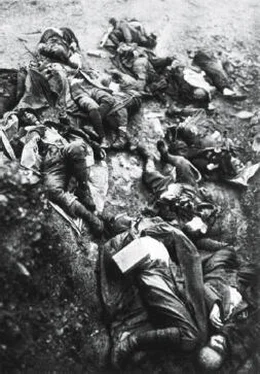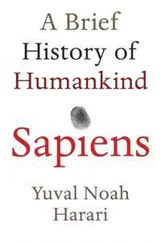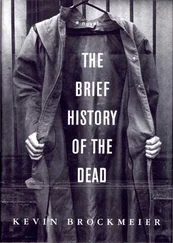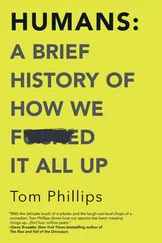Poverty certainly causes many other health problems, and malnutrition shortens life expectancy even in the richest countries on earth. In France, for example, 6 million people (about 10 per cent of the population) suffer from nutritional insecurity. They wake up in the morning not knowing whether they will have anything to eat for lunch; they often go to sleep hungry; and the nutrition they do obtain is unbalanced and unhealthy – lots of starch, sugar and salt, and not enough protein and vitamins. 3Yet nutritional insecurity isn’t famine, and France of the early twenty-first century isn’t France of 1694. Even in the worst slums around Beauvais or Paris, people don’t die because they have not eaten for weeks on end.
The same transformation has occurred in numerous other countries, most notably China. For millennia, famine stalked every Chinese regime from the Yellow Emperor to the Red communists. A few decades ago China was a byword for food shortages. Tens of millions of Chinese starved to death during the disastrous Great Leap Forward, and experts routinely predicted that the problem would only get worse. In 1974 the first World Food Conference was convened in Rome, and delegates were treated to apocalyptic scenarios. They were told that there was no way for China to feed its billion people, and that the world’s most populous country was heading towards catastrophe. In fact, it was heading towards the greatest economic miracle in history. Since 1974 hundreds of millions of Chinese have been lifted out of poverty, and though hundreds of millions more still suffer greatly from privation and malnutrition, for the first time in its recorded history China is now free from famine.
Indeed, in most countries today overeating has become a far worse problem than famine. In the eighteenth century Marie Antoinette allegedly advised the starving masses that if they ran out of bread, they should just eat cake instead. Today, the poor are following this advice to the letter. Whereas the rich residents of Beverly Hills eat lettuce salad and steamed tofu with quinoa, in the slums and ghettos the poor gorge on Twinkie cakes, Cheetos, hamburgers and pizza. In 2014 more than 2.1 billion people were overweight, compared to 850 million who suffered from malnutrition. Half of humankind is expected to be overweight by 2030. 4In 2010 famine and malnutrition combined killed about 1 million people, whereas obesity killed 3 million. 5
Invisible Armadas
After famine, humanity’s second great enemy was plagues and infectious diseases. Bustling cities linked by a ceaseless stream of merchants, officials and pilgrims were both the bedrock of human civilisation and an ideal breeding ground for pathogens. People consequently lived their lives in ancient Athens or medieval Florence knowing that they might fall ill and die next week, or that an epidemic might suddenly erupt and destroy their entire family in one swoop.
The most famous such outbreak, the so-called Black Death, began in the 1330s, somewhere in east or central Asia, when the flea-dwelling bacterium Yersinia pestis started infecting humans bitten by the fleas. From there, riding on an army of rats and fleas, the plague quickly spread all over Asia, Europe and North Africa, taking less than twenty years to reach the shores of the Atlantic Ocean. Between 75 million and 200 million people died – more than a quarter of the population of Eurasia. In England, four out of ten people died, and the population dropped from a pre-plague high of 3.7 million people to a post-plague low of 2.2 million. The city of Florence lost 50,000 of its 100,000 inhabitants. 6
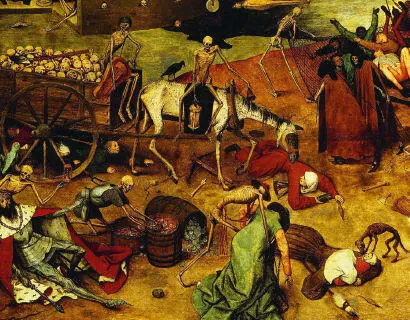
Medieval people personified the Black Death as a horrific demonic force beyond human control or comprehension.
The Triumph of Death , c .1562, Bruegel, Pieter the Elder © The Art Archive/Alamy Stock Photo.
The authorities were completely helpless in the face of the calamity. Except for organising mass prayers and processions, they had no idea how to stop the spread of the epidemic – let alone cure it. Until the modern era, humans blamed diseases on bad air, malicious demons and angry gods, and did not suspect the existence of bacteria and viruses. People readily believed in angels and fairies, but they could not imagine that a tiny flea or a single drop of water might contain an entire armada of deadly predators.
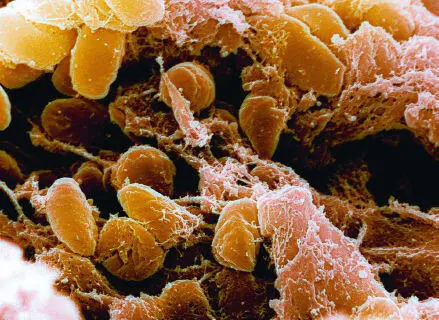
The real culprit was the minuscule Yersinia pestis bacterium.
© NIAID/CDC/Science Photo Library.
The Black Death was not a singular event, nor even the worst plague in history. More disastrous epidemics struck America, Australia and the Pacific Islands following the arrival of the first Europeans. Unbeknown to the explorers and settlers, they brought with them new infectious diseases against which the natives had no immunity. Up to 90 per cent of the local populations died as a result. 7
On 5 March 1520 a small Spanish flotilla left the island of Cuba on its way to Mexico. The ships carried 900 Spanish soldiers along with horses, firearms and a few African slaves. One of the slaves, Francisco de Eguía, carried on his person a far deadlier cargo. Francisco didn’t know it, but somewhere among his trillions of cells a biological time bomb was ticking: the smallpox virus. After Francisco landed in Mexico the virus began to multiply exponentially within his body, eventually bursting out all over his skin in a terrible rash. The feverish Francisco was taken to bed in the house of a Native American family in the town of Cempoallan. He infected the family members, who infected the neighbours. Within ten days Cempoallan became a graveyard. Refugees spread the disease from Cempoallan to the nearby towns. As town after town succumbed to the plague, new waves of terrified refugees carried the disease throughout Mexico and beyond.
The Mayas in the Yucatán Peninsula believed that three evil gods – Ekpetz, Uzannkak and Sojakak – were flying from village to village at night, infecting people with the disease. The Aztecs blamed it on the gods Tezcatlipoca and Xipe, or perhaps on the black magic of the white people. Priests and doctors were consulted. They advised prayers, cold baths, rubbing the body with bitumen and smearing squashed black beetles on the sores. Nothing helped. Tens of thousands of corpses lay rotting in the streets, without anyone daring to approach and bury them. Entire families perished within a few days, and the authorities ordered that the houses were to be collapsed on top of the bodies. In some settlements half the population died.
In September 1520 the plague had reached the Valley of Mexico, and in October it entered the gates of the Aztec capital, Tenochtitlan – a magnificent metropolis of 250,000 people. Within two months at least a third of the population perished, including the Aztec emperor Cuitláhuac. Whereas in March 1520, when the Spanish fleet arrived, Mexico was home to 22 million people, by December only 14 million were still alive. Smallpox was only the first blow. While the new Spanish masters were busy enriching themselves and exploiting the natives, deadly waves of flu, measles and other infectious diseases struck Mexico one after the other, until in 1580 its population was down to less than 2 million. 8
Two centuries later, on 18 January 1778, the British explorer Captain James Cook reached Hawaii. The Hawaiian islands were densely populated by half a million people, who lived in complete isolation from both Europe and America, and consequently had never been exposed to European and American diseases. Captain Cook and his men introduced the first flu, tuberculosis and syphilis pathogens to Hawaii. Subsequent European visitors added typhoid and smallpox. By 1853, only 70,000 survivors remained in Hawaii. 9
Читать дальше
Конец ознакомительного отрывка
Купить книгу
